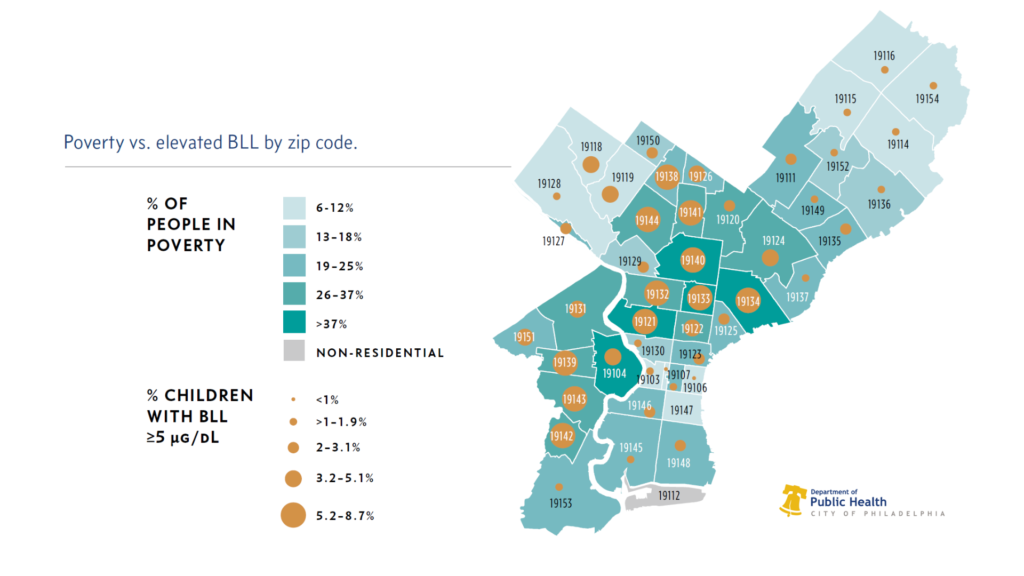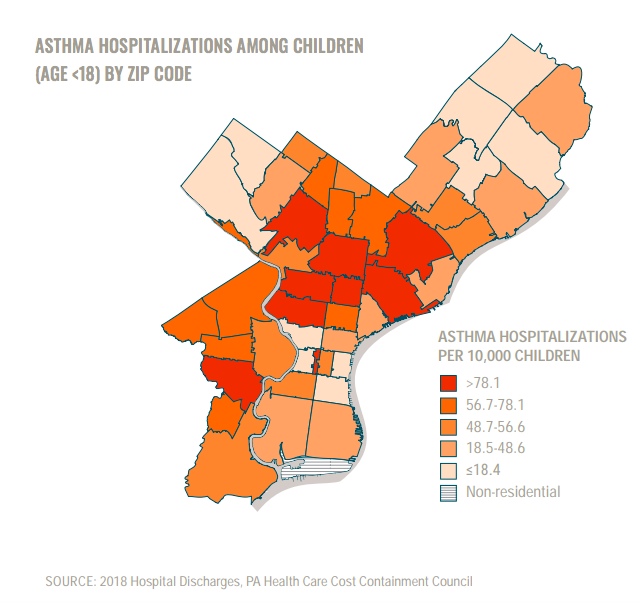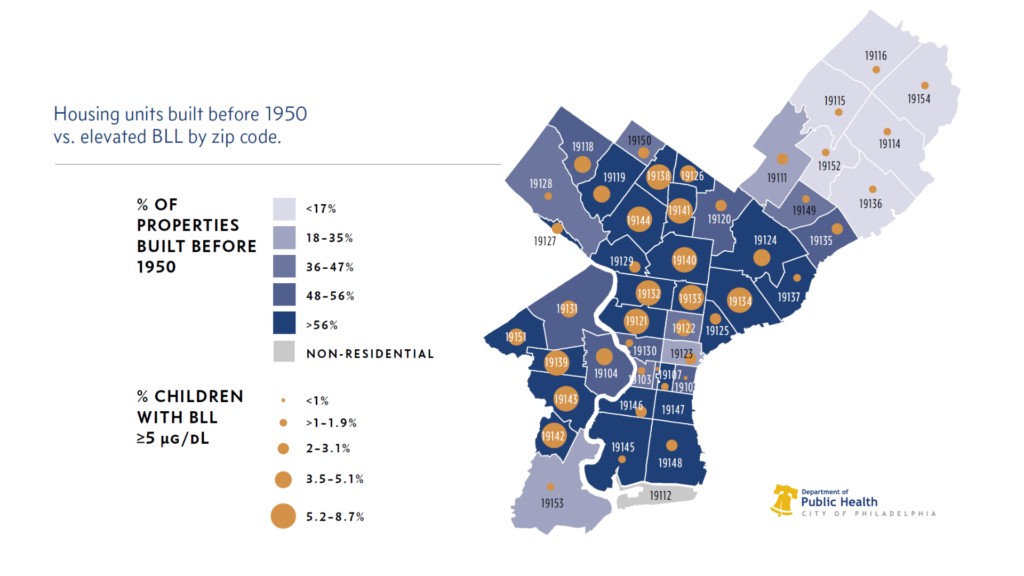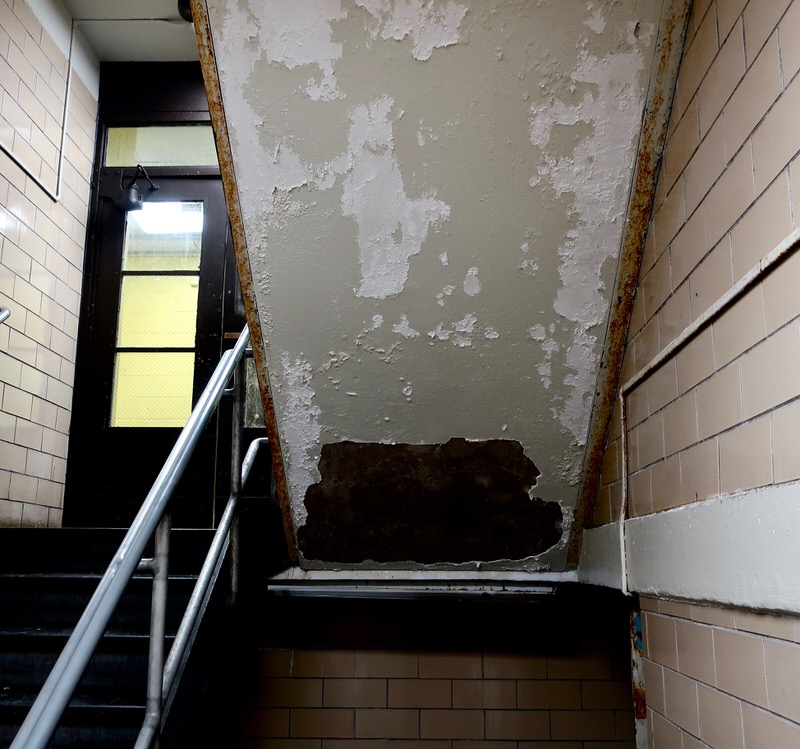Today we celebrate the 5th annual Children’s Environmental Health Day. Children’s Environmental Health Day serves as an opportunity to reflect on the progress Philadelphia has made in addressing environmental threats that face children in our region. Through the determined work of local non-profits, government agencies, and universities, Philadelphia has taken major steps to reduce childhood lead-poisoning and childhood asthma through initiatives targeted to improve the home environment. However, gaps in protection remain and action still needs to be taken to protect Philadelphia children from environmental hazards. Due to aging infrastructure and inadequate maintenance, Philadelphia schools have remained a health hazard to the children that attend them. Improving the school environment must be a priority for Philadelphia moving forward.
COMBATING CHILDHOOD LEAD POISONING THROUGH RENTAL LAWS
Lead poisoning of young children remains a major issue in Philadelphia. In 2018, the Philadelphia Department of Public Health identified 1,568 new cases of elevated blood lead levels among children less than 6 years. As an old, industrial city, Philadelphia is burdened with many sources of lead in the environment, including lead from lead-based paint, found in buildings built before 1978, lead in drinking water, due to lead service lines, and lead in soil, due to the former use of lead in gasoline and past industrial sites.
 Children in Philadelphia are exposed to lead primarily through lead-based paint found in their homes, nearly 90% of which were built before 1978, when lead-based paint was banned. These older housing units built before lead-based paint was banned is strongly associated with elevated blood lead levels in children. Poverty can be associated with dilapidated housing conditions, a risk factor for elevated blood lead levels. The highest rates of elevated blood lead levels are found in North and West Philadelphia, the most economically disadvantaged regions of Philadelphia.
Children in Philadelphia are exposed to lead primarily through lead-based paint found in their homes, nearly 90% of which were built before 1978, when lead-based paint was banned. These older housing units built before lead-based paint was banned is strongly associated with elevated blood lead levels in children. Poverty can be associated with dilapidated housing conditions, a risk factor for elevated blood lead levels. The highest rates of elevated blood lead levels are found in North and West Philadelphia, the most economically disadvantaged regions of Philadelphia.
There is no safe level of lead exposure, especially for infants and young children. Lead poisoning can cause irreversible damage, including lower IQ and lifelong learning and behavioral problems.
One of the most significant actions taken to protect Philadelphia children from lead in their homes was the passing of the Rental Property Lead Certification Law in September 2019. This law requires all landlords to test and certify their rental properties as lead-safe or lead-free.
The successful passage of the Rental Property Lead Certification bill was largely due to the unrelenting support from Councilwoman Blondell Reynolds Brown and activism from many local organizations, most notably Public Citizens for Children and Youth (PCCY). The 2019 Rental Property Lead Certification Law went into effect on October 1, 2020. This monumental bill will work to protect Philadelphia children from the dangers of lead paint in rental homes as long as it is enforced. There is still much work to do to ensure children in owned homes are safe.
ADDRESSING CHILDHOOD ASTHMA IN THE HOME
In Philadelphia, 21% of children have asthma, which is more than double the national rate. Indoor and outdoor air pollution are major contributors to the high prevalence of asthma in Philadelphia. Common in home asthma triggers include tobacco smoke, dust mites, pests, mold, and even cleaning products. Outdoor air pollution is a major concern for children living close to busy roadways or industrial facilities.
Asthma affects a child’s health as well as their academic performance. Asthma-related school absenteeism affects the majority of children with asthma and is linked to lower academic performance, especially among urban minority youth. Asthma is also a leading cause of emergency room visits for children. Now more than ever, it is important to put measures in place to prevent unneeded visits to the hospital. In Philadelphia, the rate of asthma related hospitalizations is 59 hospitalizations per 10,000 children. Non-Hispanic black and Hispanic children had the highest rates of asthma-related hospitalizations in Philadelphia, roughly 5 times higher than that of non-Hispanic white children.
visits for children. Now more than ever, it is important to put measures in place to prevent unneeded visits to the hospital. In Philadelphia, the rate of asthma related hospitalizations is 59 hospitalizations per 10,000 children. Non-Hispanic black and Hispanic children had the highest rates of asthma-related hospitalizations in Philadelphia, roughly 5 times higher than that of non-Hispanic white children.
Dr. Tyra Bryant-Stevens from the Children’s Hospital of Philadelphia (CHOP) has been working to address these disparities in Philadelphia for over 20 years. Dr. Bryant-Stevens founded the Community Asthma Prevention Program (CAPP), a comprehensive program aimed to improve asthma knowledge, control, and quality of life for participants by providing free asthma education classes at schools, churches, daycares, and community centers, home visits to address the home environment of children with asthma and provide one-on-one education, and asthma resources for professionals, students, and schools. In 2018, CAPP launched CAPP+ Home Repairs Program, an extension of their program that includes home repairs aiming to further reduce asthma-related emergency department (ED) visits and hospitalizations by removing asthma triggers in the home. Through their partnership with the Philadelphia Housing Development Corporation (PHDC), CAPP+ is able to offer repairs to address mold, water intrusion, and pests in the home.
Since its inception, CAPP has conducted over 20,000 home-based asthma visits, educated 3,000 caregivers in community education classes, taught more than 600 children in school-based asthma classes, and provided site-based asthma trainings for hundreds of primary care providers. This program has served as a model for how to conduct successful community-based public health interventions.
For more information, contact CAPP at (215) 590-5261 or through their online contact form.
While addressing indoor air pollutants is important to reduce asthma rates, improvements in outdoor air pollution in Philadelphia are essential if we expect to reduce Philadelphia rates to those of the rest of the Commonwealth of PA.
PROBLEMS REMAIN AT SCHOOLS
Philadelphia schools are currently facing a facilities crisis that is reflective of years of systemic deferred maintenance, and children are paying the price. Philadelphia schools are on average 70 years old. Due to their age, and lack of proper maintenance, these schools are plagued by flaking lead-based paint, lead in drinking water, damaged asbestos materials, and mold growth.
Recently the Philadelphia City Council has put forth legislation addressing several environmental hazards present in Philadelphia schools, including testing and reporting for lead in water and inspections for lead paint. Asbestos in schools is currently mandated under the EPA Asbestos Hazard Emergency Response Act (AHERA) that requires building inspections every three years. Although these laws are in place, enforcement and timely remediation is an ongoing problem. In December 2019, it was uncovered that 70% of Philadelphia charter schools did not have any publicly available water quality tests, as is required by a 2017 law.
There are currently no requirements for mold testing in Philadelphia schools. Mold grows in areas with a lot of moisture. In schools, this is usually due to roof and plumbing leaks or excess humidity due to uncontrolled indoor temperatures. These circumstances are common in schools. Mold has been formally reported in 142 schools in Philadelphia, which enroll over 88,000 students. In the summer of 2017, nearly 25,000 square-feet of mold was found on carpets, desks, chairs, walls, and the ventilation system in Munoz-Marin Elementary School, in North Philadelphia. Only a few months later, John B Kelly Elementary School, also in North Philadelphia, closed for a week due to a massive mold outbreak. To date, John B Kelly Elementary has received almost 200 reports of mold and three other schools have reported over 100 reports of mold, just in 2017 alone.
Mold can trigger asthma attacks and allergic reactions. The rates of asthma-related hospitalizations are highest among children living in North and West Philadelphia, which are the same neighborhoods that see the most closures of schools due to environmental issues. These infrastructure problems present in Philadelphia schools are an example of environmental injustice faced by low-income, minority children in Philadelphia.
The Philly Healthy Schools Initiative (PHSI) has been working to combat these hazards present in schools. PSHI is a coalition of parents, school faculty, students, community members, and public health experts aimed to develop plans to address the environmental hazards found in Philadelphia school buildings. One of their most recent initiatives, launched through their partner the Philadelphia Federation of Teachers (PFT), was the development of an app, PFT Healthy Schools Tracker App. Through this app students and teachers can report hazards they see in their schools. These reports, which include location, type and magnitude of problem, and photos, are sent to PHSI, who then sends summarized reports to the School District of Philadelphia. This app promotes citizen-science and engagement with students about the issues present in their schools. Knowing where and how bad problems are is the first step. Developing a strategy on how to safely and efficiently fix them is necessary.
Philadelphia has made good progress to protect children from environmental hazards in their homes. It is time to expand that coverage to their schools as well. Keeping schools clean and in healthy condition must be a non-negotiable priority to ensure the health and safety of the children who attend them. Creating a safe school environment for all Philadelphia children is one step towards improved environmental health and environmental justice.








5th Annual Children’s Environmental Health Day is an occasion to reflect on Philadelphia’s accomplishments in tackling environmental hazards to children. Philadelphia has made significant progress in reducing childhood lead poisoning and childhood asthma via measures aimed at improving the home environment. However, loopholes in protection exist, and more must be done to safeguard Philadelphia’s youngsters. Philadelphia schools continue to be a health threat for students due to outdated infrastructure and poor upkeep. Philadelphia must prioritize improving school environments.
I would never send my child to a risky school like Philadelphia. Where environmental and risky remains. Children’s lungs are so weak that the toxic lead again? oh my god, Children’s lungs can be damaged and cancer can occur. Looking at the picture, it is understood that there is a maximum risk of earthquake. Since PFT health and welfare, Martha Washington should highlight the matter to the authorities or the government. Education and wellness are equal for all.
[…] have asthma, which is more than the national average. Researchers at the University of PennsylvaniaRecognizeIncreased levels of pollution are a major factor, especially in areas near industrial […]
[…] have asthma, which is higher than the national rate. Researchers at the University of Pennsylvania acknowledge that increased levels of air pollution are a primary contributor, especially in neighborhoods near […]
[…] have asthma, which is higher than the national rate. Researchers at the University of Pennsylvania acknowledge that increased levels of air pollution are a primary contributor, especially in neighborhoods near […]
[…] 앓고 있으며 이는 전국 비율보다 높습니다. 펜실베니아 대학교 연구원 인정하다 증가된 수준의 대기 오염이 특히 산업 현장 근처의 지역에서 주요 […]
Renting a cable modem from your service provider can be a costly affair. More so when you opt for Internet + Voice plans from ISPs like Comcast Xfinity. Being a frequent collaborator with Xfinity and other cable services gives Arris cable https://rushnetworkings.com/arris-g36-review
have asthma, which is higher than the national rate. Researchers at the University of Pennsylvania acknowledge that increased levels of air pollution are a primary contributor, especially in neighborhoods near […
https://rushnetworkings.com/netgear-cm1100-vs-cm1200
[…] community, called the Black Bottom. Openly upholding industries that intentionally place dirty fossil fuel infrastructure in Black and Brown communities; declaring the area “blighted” and displacing thousands; building a militarized, enormous […]
[…] community, called the Black Bottom. Openly upholding industries that intentionally place dirty fossil fuel infrastructure in Black and Brown communities; declaring the area “blighted” and displacing thousands; building a militarized, enormous […]
[…] affliction in Philadelphia. Scientists on the College of Pennsylvania beforehand discovered that 21% of Philly kids have bronchial asthma, which is greater than double the nationwide fee. Outside air pollution is a serious set off for […]
[…] affliction in Philadelphia. Researchers at the University of Pennsylvania previously found that 21% of Philly children have asthma, which is more than double the national rate. Outdoor pollution is a major contributing factor to […]
Philadelphia must prioritize improving school environments.
Education and wellness are equal for all. Philadelphia must prioritize improving school environments.